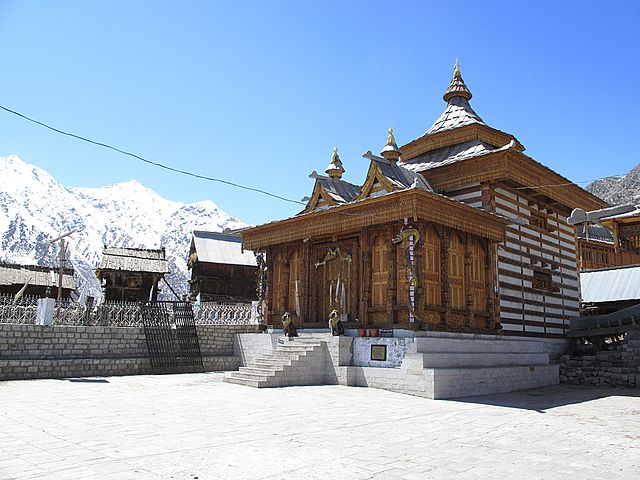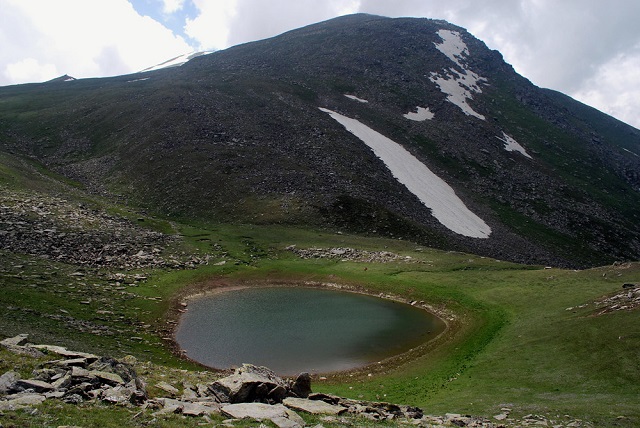- Is Chitkul a hill station for the vacation?
- Where does India end in the north-on the side of Himachal Pradesh?
- Is the end of India’s land on its north side covered with the Indian Army?
- How many Indian’s live in the last landmass of India in Himachal Pradesh?
- How is the weather in Chitkul, the last village in India?
Let us know all about Chitkul, the last inhabited village of India in Himachal Pradesh.
Location of Chitkul village:
Chitkul is the last village owned by India in Himachal Pradesh state’s Kinnaur district.
It is situated at an altitude of over 11,300 feet! Therefore, it will be covered in snow for most part of the year.
The total Indians living in this village is less than 1000!
Here is another view of Chitkul, India.

How to go to Chitkul?

The closest railway station to Chitkul village is Shimla, the capital of Himachal Pradesh.
From Shimla, you can drive to this last village of India. The distance between Shimla to Chitkul is 125 km.
On the way, your first stop is at Narkand, a beautiful ski resort and important hill station beyond Shimla. Narkand is located 70 km from Shimla.
From Narkand to Chitkul, the drive along the Sutlej River will be awesome.
In order to reach Shimla on your way to Chitkul, you can enjoy a pleasant and scenic toy train ride from Kalka, near Chandigarh city.
Can I go get a direct bus to Chitkul from New Delhi?
Yes! You can! The Himachal Pradesh Road Transport Corporation (HRTC) operates bus services from Delhi directly. If you are based in Chandigarh, you can take a direct bus to Chitkul via Shimla.
The nearest airport to Chitkul is in Chandigarh.
Where is the border between India and Tibet? How far it is from Chitkul village?
From the point you enter Chitkul village, the India-Tibet border is about 30 km away.
What to do in Chitkul and Narkand?

Since you will be crossing Narkand on your way to Chitkul, you might as well know what to do in Narkand.
Narkand’s altitude is 8800 feet! It is an alpine height where you can’t find a big range of flora except the winter trees ‘fir’ and maples.
Here are some of the best places to visit in Narkanda:
-
Hatu Peak trekking

Hatu Peak is a trekkers’ delight. The scenic beauty of the snow-clad Himalayas, the silence of the fir forest, the sound of gurgling mountain streams and the wildflowers goad avid Himalayan trekkers to visit Narkand.
The Hatu Peak situated at a height of 11,000+ feet!
-
Hatu Mata temple

The Hatu Mata temple situated on top of the Hatu Mountain in beautiful Shivalik Hills Range.
What to do in Chitkul? What are the best attractions in the last village of India?
- Mathi Temple, Chitkul

The temple looks serene and believed to be more than 5 centuries old.
-
Kinnaur Kailash Mountain Parikrama

I think you might not have heard of the holy parikrama of this sacred Kinnaur Kailash Mountain. This is not the ‘Kailash’ mountain that we all know; that is located inside Tibet.
Did you see the solitary mountain peak in the image above? It stands at a staggering height of approximately 20,000 feet!
No wonder, its circumambulation (parikrama) is arduous and sacred. Surprisingly, the Buddhists also consider this mountain as holy.
-
Sangla Valley
The Sangla Valley is another trekkers’ delight in this part of Himachal Pradesh.
-
Sangla Lake

What a solitary beauty! These kinds of off-beaten water bodies are the identities of Himalayan trekking. The Sangla Lake will cross your hiking path to Sangla Valley.
-
Baspa River and Valley

Your eyes don’t get tired of seeing these alpine rivers and lakes-eh?
The Baspa River is a perennial river because it draws its source from the Himalayan glaciers. The Baspa valley is a scenic tourist landmark to the travelers of Chitkul village.
-
Chung Shakhago Pass
Ah, the name of the Himalayan Pass indicates it is an Indo-Tibetan mountain pass. When you are taken by the guide to the Sangla Valley, the Chung Shakhago Pass greets you at the start of your trekking point in the Sangla Valley.
-
Flower gardens and apple orchards of Chitkul Village
Remember, you should plan your trip to India’s last village bordering Tibet only during the spring season. At this time, the entire village brightly lit with myriad flowers and blooms.
Apart from the flowers, you will see the sparse peasants are busy tending to the apple orchards. I believe the famous Himalayan Green Apple largely cultivated here.
-
Ranikanda Meadows
You can visualize typical Himalayan meadows at the start of your hiking trip to Ranikanda Meadows from Chitkul. The trekking path stretches up to 10 km and let me tell you, the road is not silken smooth. But then, the joy of trekking on the Himalayas lies in hiking rough terrain-right?
Finally, it is time to wind our memorable trip to the last village of India, located on the very high altitudes of Himachal Pradesh.
I have once visited Mana, another last village of India located in the Mana Pass, near the holy Badrinath temple.
The feeling of visiting such remote and tourist-important places of India is oddly nonchalant but it gives goosebumps.
Accommodations in Chitkul.
Not a great range of places to stay in Chitkul as it is still a border village with really nothing much to do. Airbnb offers some type of basic accommodation but that tends to vary.
You can find some Homestay options which I believe is a better option than getting curled up in a dingy hotel room.
Eating in Chitkul
I think there is just a lone restaurant in the town.
It is better to make a day trip to Chitkul staying from Shimla.
Conclusion
Look, take a sudden break from your routine by hitting the Himalayas and going up to the last village of India for much-needed relaxation.
The stunning views of the various valleys, rivers including the Sutlej and Baspa, the high glaciers and the unassuming villagers are all worth your intuitive trip.
When you visit Chitkul, take a few photographs and share it with me through ‘comments’ box of this blog.


